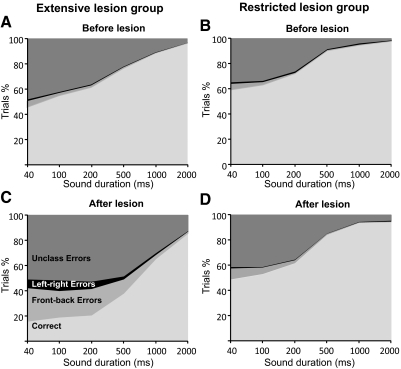Fig. 1.
Overall performance on the approach-to-target task for both groups before (A and B) and after (C and D) either extensive (A and C) or restricted (B and D) cortical lesions were made. Each panel shows the cumulative percentages of trials for the different sound durations used. Trials are sorted into those in which correct responses were made and, for the incorrect responses, are further subdivided into left-right errors (responses made to the hemifield contralateral to the target), front-back errors (responses made to the anterior hemifield following presentation of sounds in the ipsilateral posterior hemifield and vice versa), and unclassified (i.e., all other) errors. Note that the proportion of incorrect responses made by the animals in the 12-speaker task increased after the lesions had been made, particularly at shorter sound durations, but a much greater impairment was observed in the extensive lesion group.

